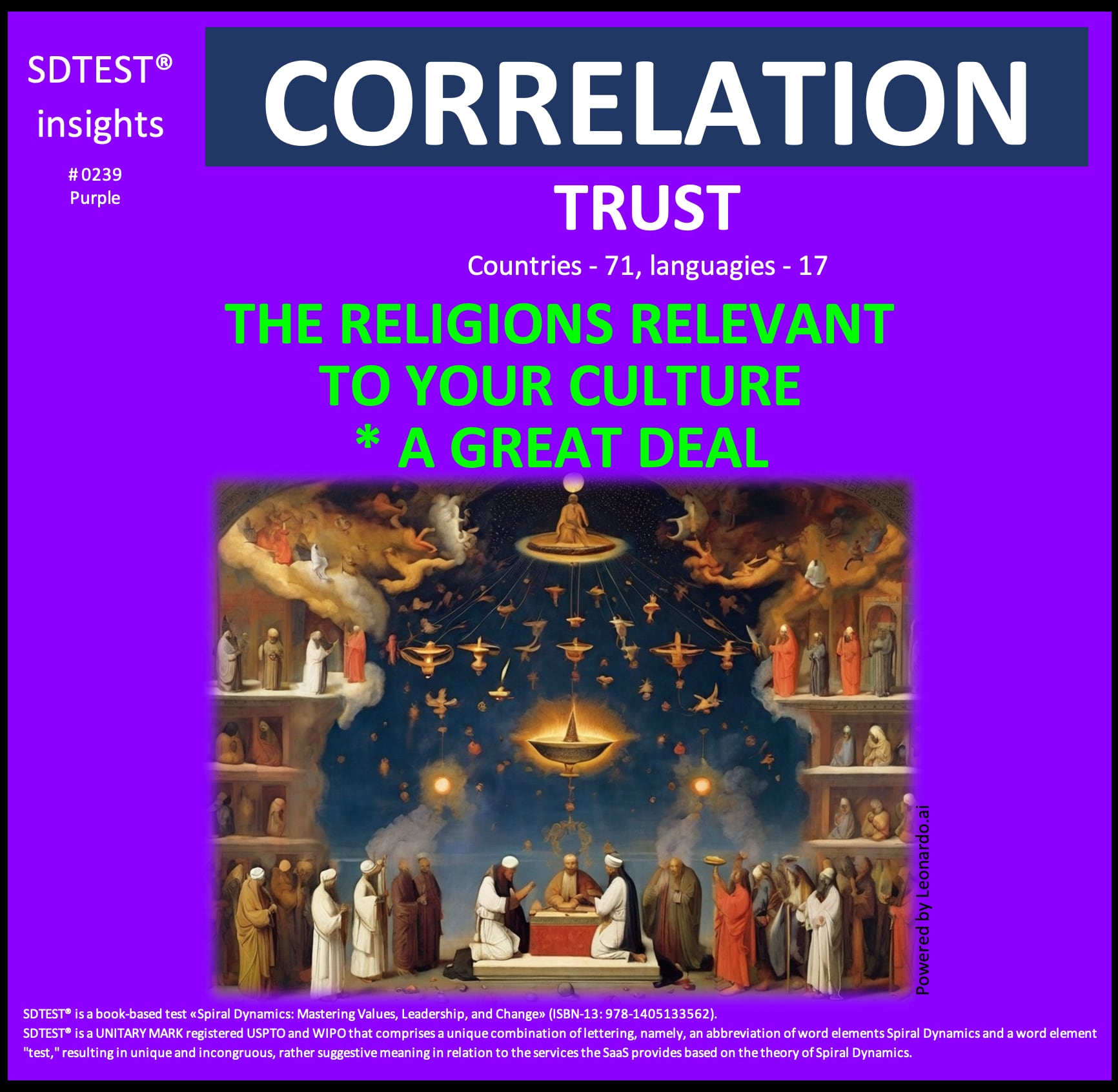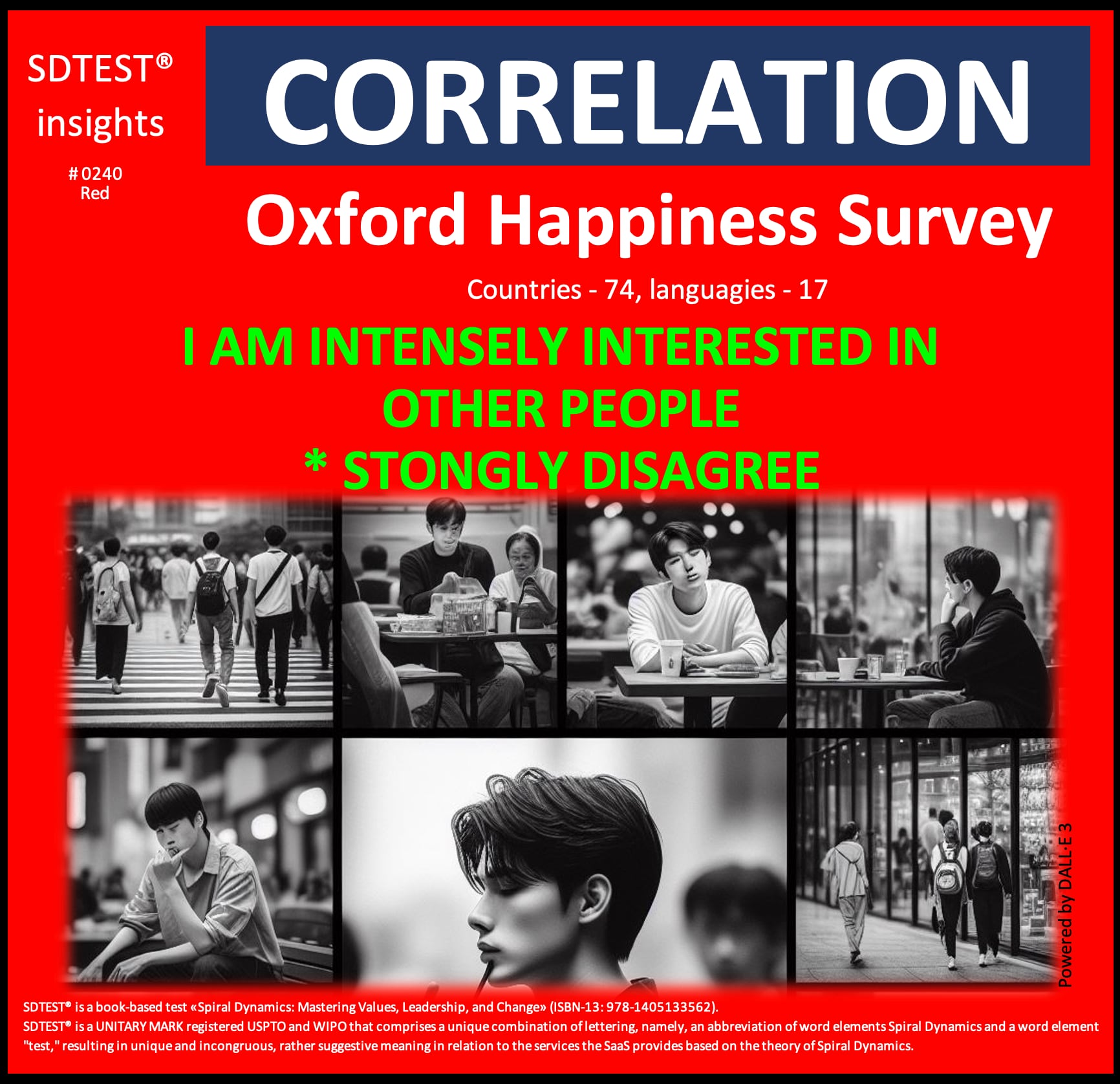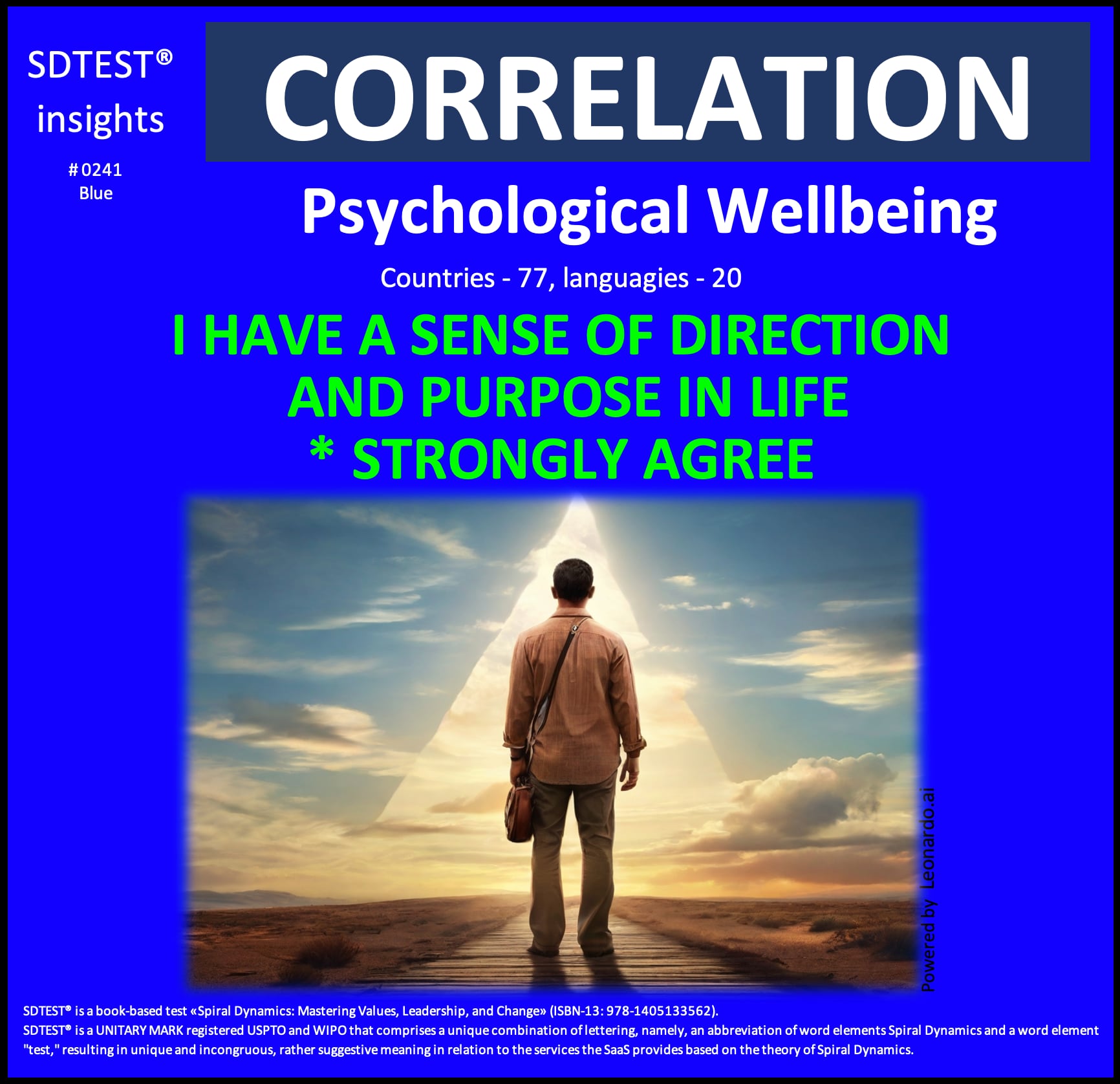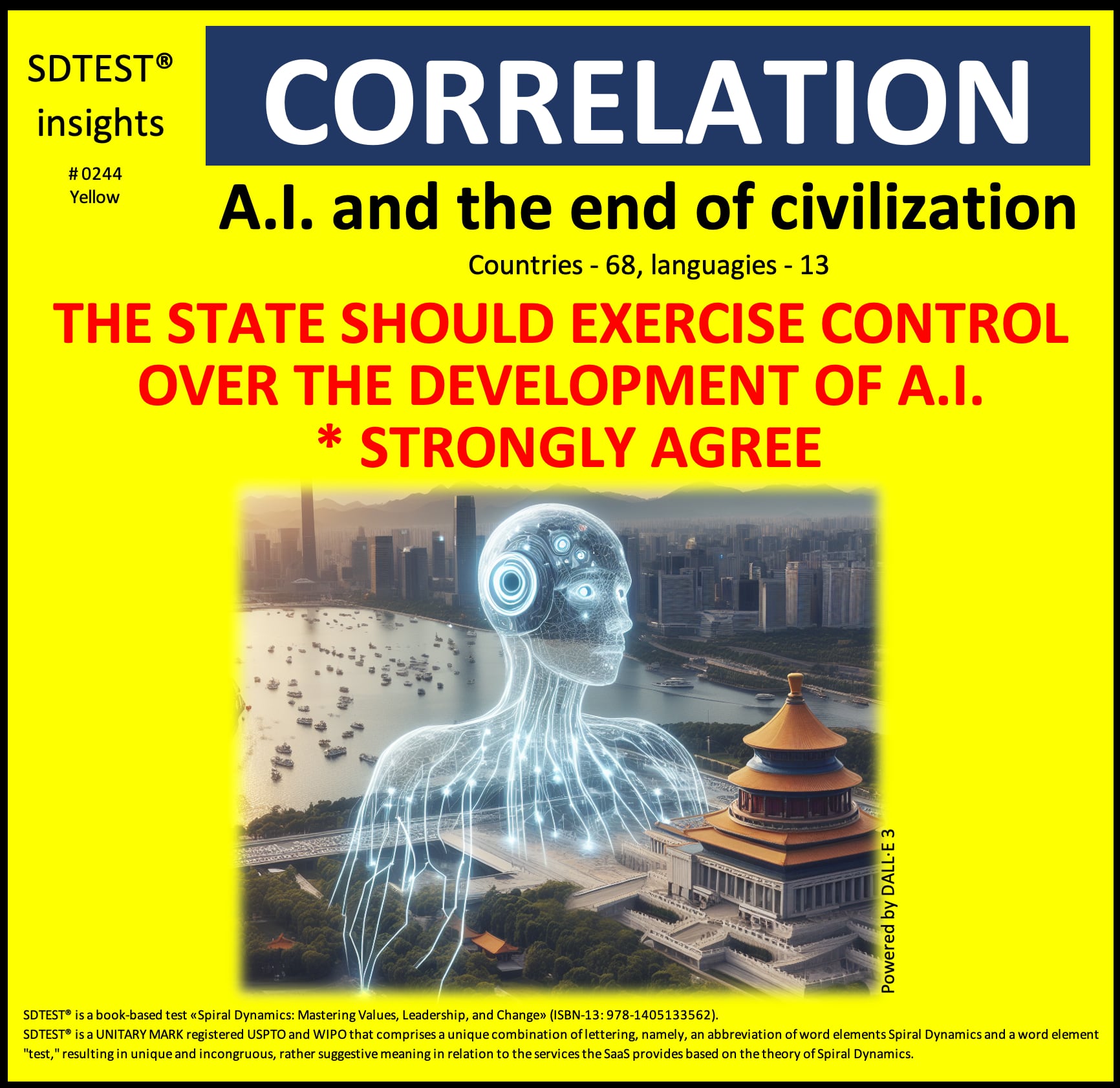We invite curiosity about the systemic mechanisms behind this correlation. There may be hidden variables that provide alternative explanations.
This positive correlation of 0.1247 between strongly disagreeing with being intensely interested in other people and the Red stage offers intriguing insights when viewed through the lens of the Red value system:
Organizational Perspective:
Organizations operating within the Red mindset might interpret this correlation as:
- Validation of their focus on individual power and organizational dominance.
- Justification for promoting a competitive, self-centered corporate culture.
- An opportunity to leverage self-interest for organizational gain.
These organizations might respond by:
- Implementing cutthroat performance metrics that pit employees against each other.
- Rewarding aggressive, self-promoting behaviors that demonstrate individual power.
- Encouraging a "winner-takes-all" mentality in project assignments and promotions.
Team Perspective
Teams operating from a Red mindset might approach this correlation by:
- Viewing it as support for prioritizing individual achievements over team cohesion.
- Interpreting it as a call to establish clear power hierarchies within the team.
- Seeing it as justification for an "every person for themselves" approach to teamwork.
These teams might respond by:
- Fostering internal competition for leadership roles and recognition.
- Minimizing collaborative efforts in favor of individual showcases of skill and power.
- Celebrating team members who assert dominance and pursue personal goals aggressively.
Individual Perspective:
Individuals aligned with the Red value system might interpret this correlation as:
- Personal validation of their self-centered approach to work and relationships.
- Justification for prioritizing personal gain over interpersonal connections.
- Confirmation that focusing on others shows weakness or ineffectiveness.
These individuals might respond by:
- Actively avoiding deep engagement with colleagues, seeing it as a distraction from personal goals.
- Viewing others primarily as tools or obstacles in pursuing power and success.
- Cultivating an image of strength and independence by openly disregarding others' interests or needs.
This correlation, viewed through the Red lens, suggests that those operating at the Red level may be particularly disinclined to show intense interest in others. It implies that the Red value system's characteristics of self-centeredness, power focus, and immediate gratification align with a lack of genuine curiosity or concern for others' experiences or perspectives.
Ultimately, this correlation speaks to the complex relationship between value systems and interpersonal engagement. In the Red worldview, intense interest in others might be seen as a potential weakness or distraction from pursuing personal power and goals.
This perspective challenges us to consider the implications of such an attitude in various contexts:
- In organizations, it might lead to highly competitive but potentially toxic work environments.
- In teams, it could result in fragmented efforts and a lack of synergy.
- For individuals, it might limit personal growth and networking opportunities.
By recognizing this tendency in Red-oriented contexts, we gain insight into the challenges of fostering collaboration, empathy, and mutual understanding in environments where self-interest and power dynamics dominate. This understanding can be crucial for developing strategies to balance individual ambition with the benefits of interpersonal connection and collective effort.
In our analysis of the poll "Psychological Wellbeing" (by Carol D. Ryff), we found an intriguing positive correlation that warrants closer examination:
0.0762 between the Purpose in life. I have a sense of direction and purpose in life / Strongly agree and the Blue stage.
The critical value of the correlation coefficient for a normal distribution, by William Sealy Gosset (Student) r = 0.0512. This positive correlation of 0.0762 meets the reliability criteria but does not necessarily imply causation.
This positive correlation of 0.0762 between strongly agreeing with having a sense of direction and purpose in life and the Blue stage offers intriguing insights when viewed through the lens of the Blue value system:
Organizational Perspective:
Organizations operating within the Blue mindset might interpret this correlation as:
- Validation of their structured, hierarchical approach to defining organizational purpose.
- Confirmation that clear rules and traditions give employees a sense of direction.
- Justification for aligning organizational goals with higher moral or spiritual purposes.
These organizations might respond by:
- Reinforcing the organization's mission statement as a guiding principle for all activities.
- Implementing strict codes of conduct that define the organization's purpose and values.
- Emphasizing the organization's role in upholding societal order and traditional values.
Team Perspective:
Teams operating from a Blue mindset might approach this correlation by:
- Viewing it as support for maintaining clear team structures and roles.
- Interpreting it as a call to align team goals with the organization's mission.
- Seeing it as confirmation that adherence to rules and procedures provides team purpose.
These teams might respond by:
- Establishing clear hierarchies and chains of command within the team.
- Regularly reinforcing the team's role in fulfilling the organization's larger purpose.
- Implementing structured processes for decision-making and task completion.
Individual Perspective:
Individuals aligned with the Blue value system might interpret this correlation as:
- Personal validation of their commitment to following established rules and traditions.
- Justification for seeking purpose through loyalty to their organization or belief system.
- Confirmation that adhering to a moral code provides life direction and meaning.
These individuals might respond by:
- Deepening their commitment to organizational or religious doctrines.
- Seeking roles that allow them to uphold and enforce rules and traditions.
- Deriving satisfaction from fulfilling their duties and responsibilities.
This correlation, viewed through the Blue lens, suggests that those operating at the Blue level may find a strong sense of purpose and direction through adherence to established norms, rules, and belief systems. It implies that the Blue value system's characteristics of order, discipline, and respect for authority align with a clear sense of life purpose.
By recognizing the importance of clear rules, traditions, and hierarchies in Blue-oriented contexts, we understand how these elements contribute to psychological well-being. This understanding can be crucial for:
- Organizations seeking to provide employees with a sense of purpose through clear structures and missions.
- Teams aiming to align their efforts with broader organizational or societal goals.
- Individuals looking to find meaning and direction through adherence to established norms and belief systems.
In essence, this correlation suggests that for those in the Blue value system, a strong sense of purpose and direction in life is closely tied to their ability to understand and fulfill their role within a larger, ordered system. Whether through organizational hierarchies, religious doctrines, or societal traditions, the Blue perspective finds meaning in upholding established structures and contributing to a greater, predefined purpose.
Ultimately, this correlation shows the complex relationship between value systems and psychological well-being. It reminds us that in the Blue worldview, purpose and direction are often derived from external sources of authority and established traditions. This perspective challenges us to consider how structured belief systems, whether organizational, religious, or societal, can provide individuals with a sense of meaning and direction.
In our analysis of the poll "Where would be your next most exciting opportunity?" we found an intriguing positive correlation that warrants closer examination:
0.1390 between the International Market leader and the Orange stage.
The critical value of the correlation coefficient for a normal distribution, by William Sealy Gosset (Student) r = 0.0574. This positive correlation of 0.1390 meets the reliability criteria but does not necessarily imply causation.
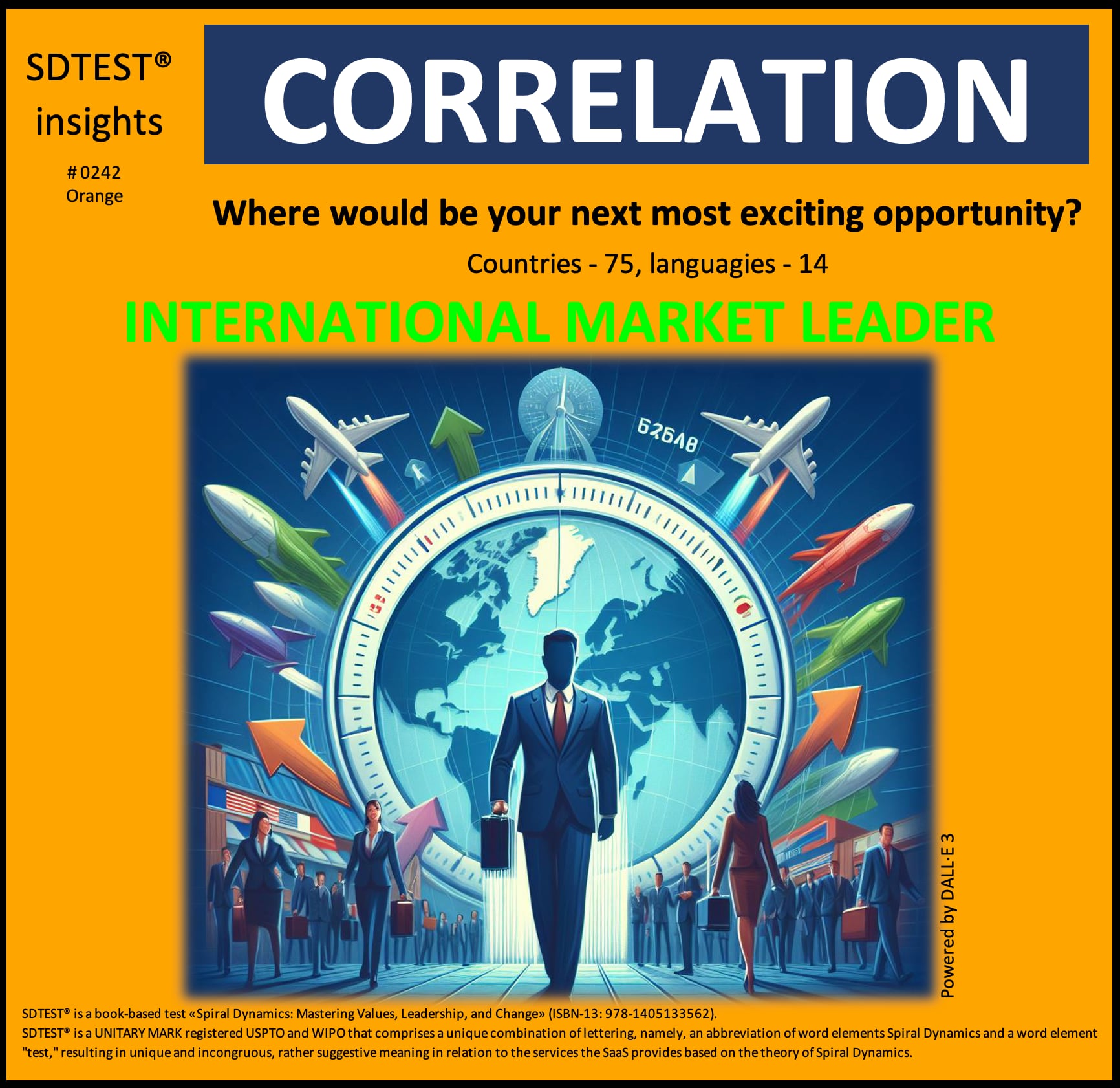
This positive correlation of 0.1390 between viewing an International Market leader as the next most exciting opportunity and the Orange stage offers intriguing insights when viewed through the lens of the Orange value system:
Organizational Perspective:
Organizations operating within the Orange mindset might interpret this correlation as:
- 1. Validation of their strategic focus on global market dominance and expansion.
- 2. Confirmation that pursuing international leadership aligns with progressive, forward-thinking values.
- 3. Justification for investing in cutting-edge technologies and innovative practices to compete globally.
These organizations might respond by:
- - Developing data-driven strategies to analyze and penetrate international markets.
- - Implementing performance metrics that prioritize global market share and leadership.
- - Investing in research and development to create innovative products for diverse global markets.
Team Perspective:
Teams operating from an Orange mindset might approach this correlation by:
- 1. Viewing it as support for adopting a competitive, results-oriented approach to international projects.
- 2. Interpreting it as a call to develop diverse skill sets necessary for global market leadership.
- 3. Seeing it as an opportunity to showcase their capabilities internationally.
These teams might respond by:
- - Implementing agile methodologies to adapt to diverse international market needs quickly.
- - Fostering a culture of continuous learning and skill development focused on global business practices.
- - Establishing cross-functional teams to tackle complex challenges in international markets.
Individual Perspective:
Individuals aligned with the Orange value system might interpret this correlation as:
- 1. Personal validation of their ambition to achieve recognition and success on a global scale.
- 2. Justification for pursuing international career opportunities and experiences.
- 3. Confirmation that focusing on global market leadership aligns with personal growth and achievement.
These individuals might respond by:
- - Actively seeking roles and projects that offer exposure to international markets.
- - Investing in developing language skills and cultural competencies for global business.
- - Pursuing advanced education or certifications in international business and global market strategies.
This correlation, viewed through the Orange lens, suggests that those operating at the Orange level may be particularly drawn to the challenge and opportunity of becoming an international market leader. It implies that the Orange value system's characteristics of ambition, rational thinking, and focus on progress and results align well with the complexities and potential rewards of global market leadership.
In essence, this correlation suggests that for those in the Orange value system, pursuing international market leadership represents an exciting confluence of personal ambition, organizational goals, and the application of rational, scientific approaches to achieve tangible results on a global scale.
Ultimately, this correlation speaks to the complex relationship between value systems and business ambitions. It reminds us that in the Orange worldview, becoming an international market leader represents the pinnacle of achievement, combining elements of innovation, competition, and measurable success that are highly valued in this system.
0.1004 between the Connect with Others and the Green stage.
The critical value of the correlation coefficient for a normal distribution, by William Sealy Gosset (Student) r = 0.0674. This positive correlation of 0.1004 meets the reliability criteria but does not necessarily imply causation.
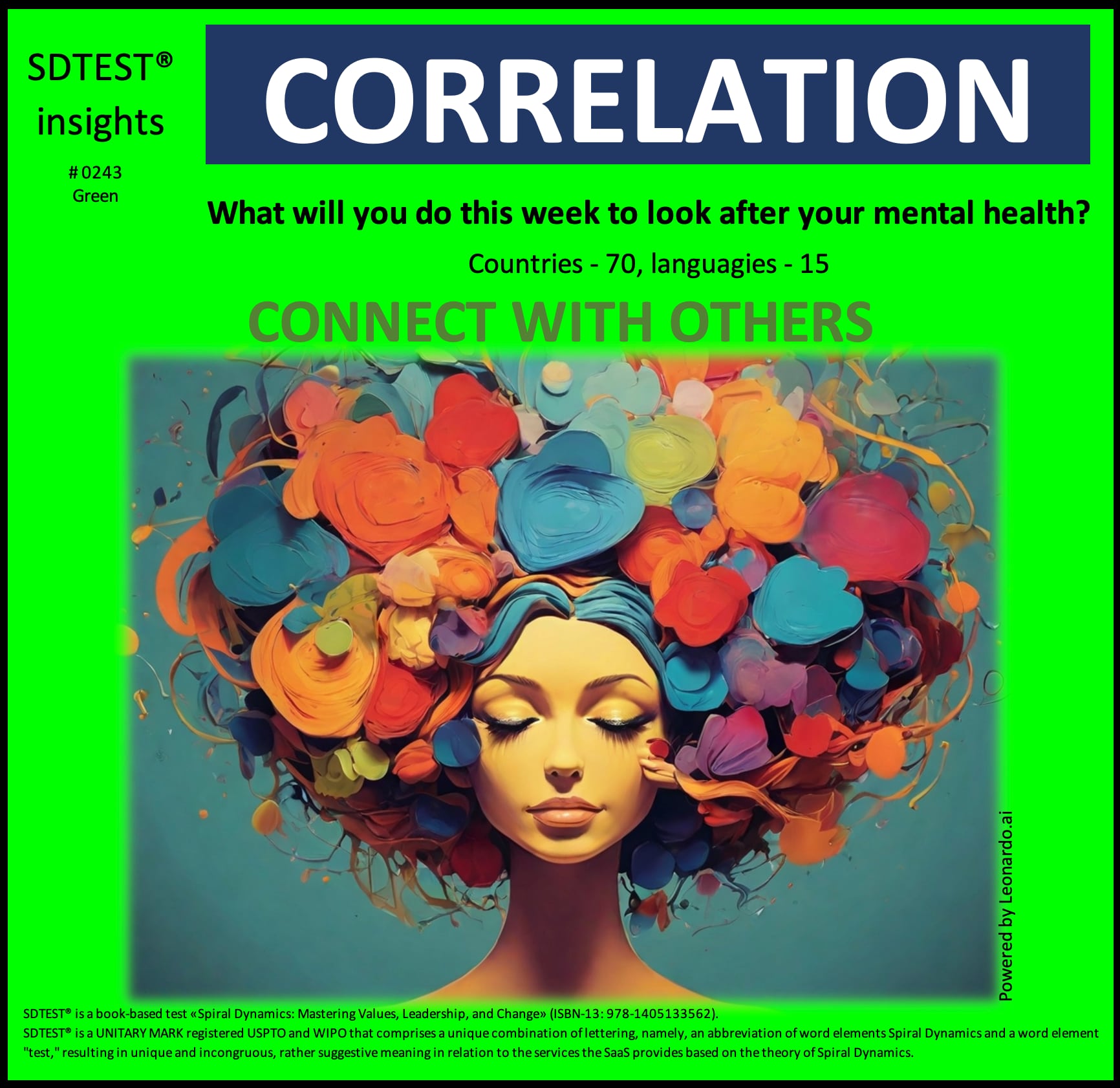
This positive correlation of 0.1004 between choosing to connect with others as a way to look after one's mental health and the Green stage offers intriguing insights when viewed through the lens of the Green value system:
Organizational Perspective:
Organizations operating within the Green mindset might interpret this correlation as:
- Validation of their focus on creating inclusive, supportive work environments.
- Confirmation that fostering interpersonal connections contributes to overall organizational well-being.
- Justification for implementing holistic wellness programs that emphasize social connections.
These organizations might respond by:
- Developing collaborative spaces and programs that encourage meaningful interactions among employees.
- Implementing policies that prioritize work-life balance and social support networks.
- Fostering a culture of open communication and emotional intelligence throughout the organization.
Team Perspective:
Teams operating from a Green mindset might approach this correlation by:
- Viewing it as support for prioritizing team cohesion and interpersonal relationships.
- Interpreting it as a call to create a more empathetic and supportive team environment.
- Seeing it as an opportunity to explore collective mental health and well-being approaches.
These teams might respond by:
- Implementing regular check-ins that focus on emotional well-being and interpersonal connections.
- Encouraging team-building activities that foster deeper understanding and empathy among members.
- Developing peer support systems within the team to address mental health concerns collaboratively.
Individual Perspective:
Individuals aligned with the Green value system might interpret this correlation as:
- Personal validation of their belief in the interconnectedness of all beings.
- Justification for prioritizing relationships and community engagement for personal well-being.
- Confirmation that seeking connection with others is a valid and essential self-care strategy.
These individuals might respond by:
- Actively seeking out opportunities for meaningful social interactions and community involvement.
- Practicing vulnerability and openness in their relationships to foster deeper connections.
- Engaging in activities that promote empathy and understanding of diverse perspectives.
This correlation, viewed through the Green lens, suggests that those operating at the Green level may be particularly inclined to recognize the importance of social connections for mental health. It implies that the Green value system's characteristics of community focus, holistic thinking, and emphasis on unity and cooperation align well with seeking interpersonal connections to maintain mental well-being.
In essence, this correlation suggests that for those in the Green value system, connecting with others is a personal coping strategy and a fundamental aspect of human well-being that reflects our interconnectedness and mutual dependence. It underscores the idea that mental health is not just an individual concern but a collective responsibility that requires us to nurture our connections with others and our broader communities.
Ultimately, this correlation speaks to the complex relationship between value systems and approaches to mental health. It reminds us that in the Green worldview, individual well-being is intrinsically linked to collective well-being and the health of our relationships and communities.
In our analysis of the poll "A.I. and the End of Civilization" (by Elon Musk), we found an intriguing negative correlation that warrants closer examination:
-0.0871 between The state should exercise control over the development of artificial intelligence / Strongly agree and the Yellow stage.
The critical value of the correlation coefficient for a normal distribution, by William Sealy Gosset (Student) r = 0.0802. This negative correlation of -0.0871 meets the reliability criteria but does not necessarily imply causation.
This negative correlation of -0.0871 between strongly agreeing that the state should exercise control over AI development and the Yellow stage offers intriguing insights when viewed through the lens of the Yellow value system:
Organizational Perspective:
Companies operating within the Yellow mindset might interpret this correlation as:
- Validation of their complex, adaptive approach to AI development and governance.
- Justification for self-regulation and ethical AI practices beyond state control.
- An opportunity to pioneer integrative, multi-stakeholder approaches to AI advancement.
These organizations might respond by:
- Developing flexible, ethical frameworks for AI that adapt to emerging challenges and opportunities.
- Implementing collaborative, cross-sector initiatives for responsible AI development.
- Fostering a continuous learning and adaptation culture in AI research and application.
Team Perspective:
Teams operating from a Yellow mindset might approach this correlation by:
- Viewing it as support for diverse, interdisciplinary approaches to AI development.
- Interpreting it autonomously as a call to balance innovation with ethical considerations.
- Seeing it as an opportunity to explore novel governance models for AI that transcend traditional state control.
These teams might respond by:
- Implementing agile, self-organizing structures to address AI challenges holistically.
- Encouraging team members to develop multifaceted skills spanning technology, ethics, and social impact.
- Fostering a culture of personal responsibility and collective wisdom in AI development.
Individual Perspective:
Individuals aligned with the Yellow value system might interpret this correlation as:
- Personal validation of their nuanced, systems-thinking approach to AI governance.
- Justification for pursuing innovative, self-directed AI research and development paths.
- Confirmation that complex global challenges like AI require integrative, adaptive solutions beyond state control.
These individuals might respond by:
- Actively seeking to understand and integrate multiple perspectives on AI governance.
- Developing personal ethical frameworks that guide their work in AI, transcending rigid rules.
- Engaging in continuous learning and adaptation to stay ahead of AI's evolving challenges.
This correlation, viewed through the Yellow lens, suggests that those operating at the Yellow level may be skeptical of state control over AI development. It implies that the Yellow value system's characteristics of integrative thinking, adaptability, and understanding of complex systems align with a more nuanced, automated approach to AI governance.
In essence, this correlation suggests that for those in the Yellow value system, the governance of AI development requires a more holistic, integrative approach that can adapt to the technology's rapid evolution and complex implications. It underscores the need for innovative, flexible frameworks that can harness the collective wisdom of diverse stakeholders while remaining agile enough to address emerging challenges in real-time.
Ultimately, this correlation speaks to the complex relationship between value systems and approaches to technological governance. It reminds us that in the Yellow worldview, the challenges posed by AI are seen as too complex and rapidly evolving for traditional state control to address effectively.
In our analysis of the poll "I live thinking about my past, present or future," we found an intriguing positive correlation that warrants closer examination:
0.0945 between the Present and the Turquoise stage.
The critical value of the correlation coefficient for a normal distribution, by William Sealy Gosset (Student) r = 0.0591. This positive correlation of 0.0945 meets the reliability criteria but does not necessarily imply causation.
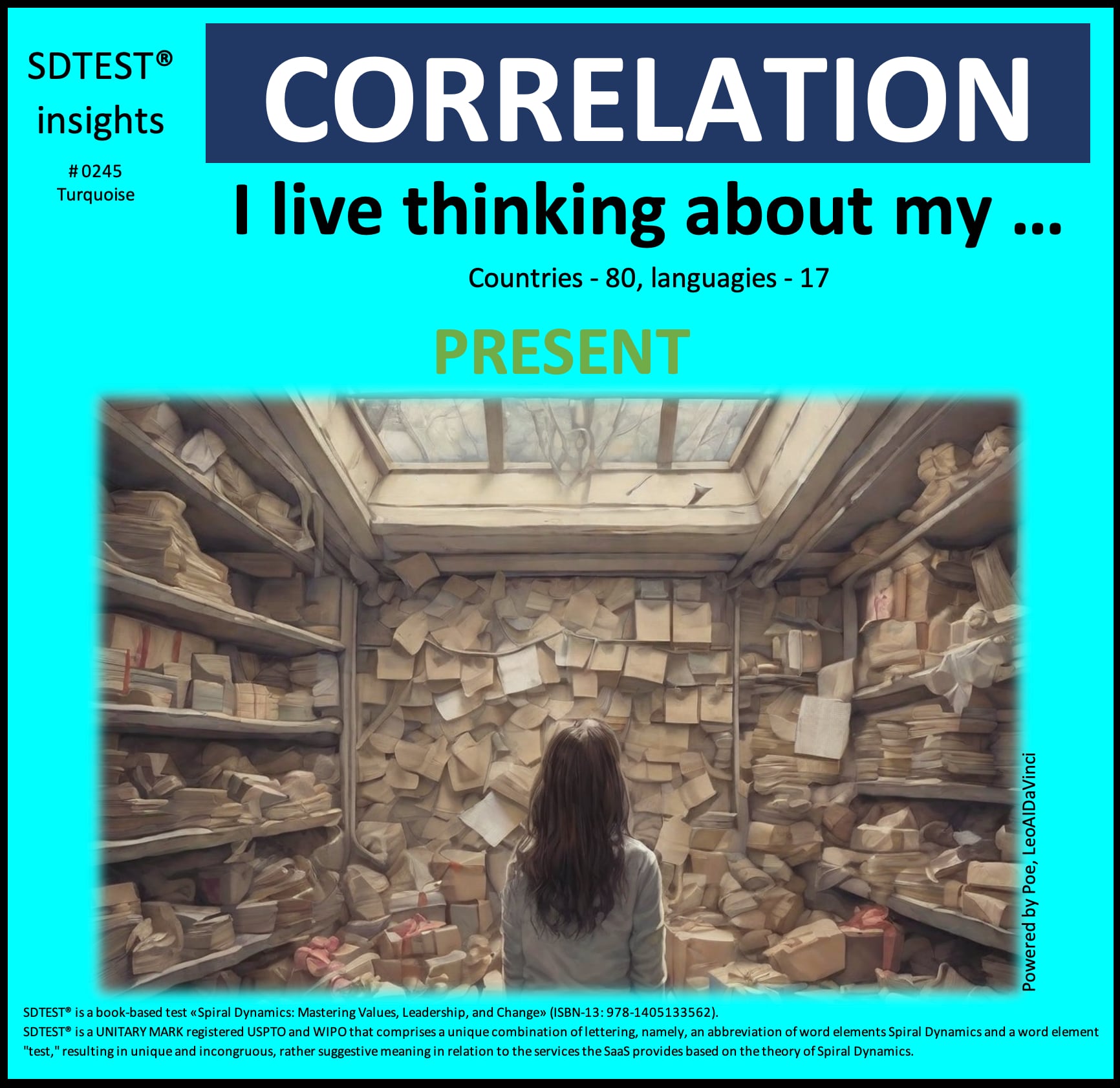
This positive correlation of 0.0945 between living thinking about the present and the Turquoise stage offers intriguing insights when viewed through the lens of the Turquoise value system:
Organizational Perspective:
Companies operating within the Turquoise mindset might interpret this correlation as:
- Validation of their focus on sustainable, present-oriented practices that honor the interconnectedness of all systems.
- Confirmation that a present-focused approach aligns with holistic, ecological thinking.
- Justification for implementing mindful, conscious decision-making processes in real time.
These organizations might respond by:
- Developing adaptive, responsive strategies that address current global challenges while considering long-term impacts.
- Implementing practices that foster awareness of the organization's immediate impact on employees, communities, and the environment.
- Creating spaces for contemplation and presence within the workplace to enhance collective consciousness.
Team Perspective:
Teams operating from a Turquoise mindset might approach this correlation by:
- Viewing it as support for cultivating collective presence and awareness.
- Interpreting it as a call to integrate mindfulness practices into team interactions and decision-making.
- Seeing it as an opportunity to deepen their understanding of the team's real-time impact on broader systems.
These teams might respond by:
- Implement regular check-ins focusing on the team's present state and immediate environmental impact.
- Encouraging practices that enhance present-moment awareness, such as group meditation or nature immersion.
- Developing decision-making processes that balance immediate needs with long-term, systemic considerations.
Individual Perspective:
Individuals aligned with the Turquoise value system might interpret this correlation as:
- Personal validation of their practice of mindful, present-centered living.
- Justification for deepening their awareness of the interconnectedness of all things in the present moment.
- Confirmation that being fully present enhances their ability to perceive and interact with complex systems.
These individuals might respond by:
- Cultivating daily mindfulness practices to enhance their presence and awareness.
- Seeking experiences that deepen their connection with the natural world in the present moment.
- Engaging in activities that allow them to fully immerse in the here and now while maintaining a broad, systemic perspective.
This correlation, viewed through the Turquoise lens, suggests that those operating at the Turquoise level may be particularly inclined to focus on the present moment. It implies that the Turquoise value system's characteristics of holistic thinking, recognition of interconnectedness, and focus on ecological harmony align well with a present-centered approach to living.
In essence, this correlation suggests that for those in the Turquoise value system, living in the present is a personal practice and a fundamental aspect of engaging with the world in a more conscious, integrated, and ecologically harmonious way. It underscores the idea that by fully inhabiting the present moment, we can better perceive and respond to the intricate interdependencies that shape our world, fostering a more sustainable and harmonious relationship with all living systems.
Ultimately, this correlation speaks to the complex relationship between value systems and temporal orientation. It reminds us that in the Turquoise worldview, being fully present is about personal well-being and enhancing our capacity to perceive and respond to the intricate web of relationships that make up our world.
What insights do you gain from today's correlation? How might we study this relationship more carefully before deducing causation?
We welcome respectful and wise perspectives! Stay tuned every week as we share more results and insights.
After login or registration, free access to the poll results in the FAQ section.

